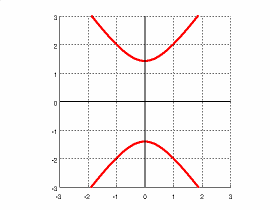- Math Lessons
- >
- Analytic Geometry
- >
- Conic Sections
- >
- Hyperbola
| « Ellipse |
|
Hyperbola
Definitions:
1. A hyperbola is the locus of points where the difference in the distance to two fixed points (called the foci) is constant.
2. A hyperbola is the set of all points $(x, y)$ in the plane the difference of whose distances from two fixed points is some constant. The two fixed points are called the foci.
A hyperbola comprises two disconnected curves called its arms or branches which separate the foci.
Hyperbola can have a vertical or horizontal orientation.
Hyperbola centered in the origin
Standard equation of a hyperbola centered at the origin (horizontal orientation)
$\frac{x^2}{a^2} - \frac{y^2}{b^2} = 1$
Example 1:
$\frac{x^2}{1} - \frac{y^2}{2} = 1$

Standard equation of a hyperbola centered at the origin (vertical orientation)
$\frac{y^2}{a^2} - \frac{x^2}{b^2} = 1$
Example 2:
$\frac{x^2}{2} - \frac{y^2}{1} = 1$

Foci
The foci for a horizontal oriented hyperbola are given by

The foci for a vertical oriented hyperbola are given by
$(\pm \sqrt{a^2 + b^2}, 0)$
Asymptote:
Asymptotes of a horizontal oriented hyperbola are determined by
$y = \frac{b}{a}x$ and $y = - \frac{b}{a}x$
Asymptotes of a vertically oriented hyperbola are determined by
$y = \frac{a}{b}x$ and $y = - \frac{a}{b}x$
Eccentricity:
The eccentricity is given by
$e = \sqrt{1 + \frac{b^2}{a^2}}$
Example 3:
Consider the equation
$\frac{x^2}{16} - \frac{y^2}{9} = 1$
Find: $a$, $b$, foci, asymptotes, and eccentricity.
$$ \begin{aligned} &a^2 = 16 \Rightarrow a = 4 \\ &b^2 = 9 \rightarrow b = 3 \end{aligned} $$
Foci:
$$ \begin{aligned} &F1: \ \ \left( - \sqrt{a^2 + b^2}, 0 \right) = \left( - \sqrt{4^2 + 3^2}, 0 \right) = (-5, 0) \\ &F2: \ \ \left( \sqrt{a^2 + b^2}, 0 \right) = \left( \sqrt{4^2 + 3^2}, 0 \right) = (5, 0) \\ \end{aligned} $$
Asymptotes:
$$ \begin{aligned} &As1: \ \ y = \frac{b}{a} x \rightarrow y = \frac{3}{4} x \\ &As2: \ \ y = - \frac{b}{a} x \rightarrow y = - \frac{3}{4} x \end{aligned} $$
Eccentricity:
$$ e = \sqrt{1 + \frac{b^2}{a^2}} = \sqrt{1 + \frac{3^2}{4^2}} = \frac{5}{4} $$
Picture:

Hyperbola centered in (u,v):
Horizontal oriented hyperbola centered at $(u, v)$
$$ \frac{(x - u)^2}{a^2} - \frac{(y - \nu)^2}{b^2} = 1 $$
Vertical oriented hyperbola centered at $(u, v)$
$$ \frac{(y - u)^2}{a^2} - \frac{(x - \nu)^2}{b^2} = 1 $$
Foci:
The foci for a horizontal oriented hyperbola centered at $(u, v)$:
$$ (u \pm \sqrt{a^2 + b^2}, \nu) $$
The foci for a vertical oriented hyperbola centered at $(u, v)$:
$$ (u, \nu \pm \sqrt{a^2 + b^2}) $$
Asymptote:
Asymptotes of a horizontal oriented hyperbola are determined by
$y = \nu + \frac{b}{a} (x - u)$ and $y = \nu - \frac{b}{a} (x - u)$
Asymptotes of a vertically oriented hyperbola are determined by
$y = u + \frac{b}{a} (x - \nu)$ and $y = u - \frac{b}{a} (x - \nu)$
Eccentricity:
The eccentricity is given by
$e = \sqrt{1 + \frac{b^2}{a^2}}$
Parametric Equations:
Horizontal oriented hyperbola:
$$ \begin{aligned} &x = a \sec t + u \\ &y = b \tan t + \nu \\ &0 \le t < 3 \pi \end{aligned} $$
Vertical oriented hyperbola:
$$ \begin{aligned} &x = a \tan t + u \\ &y = b \sec t + \nu \\ &0 \le t < 2 \pi \end{aligned} $$